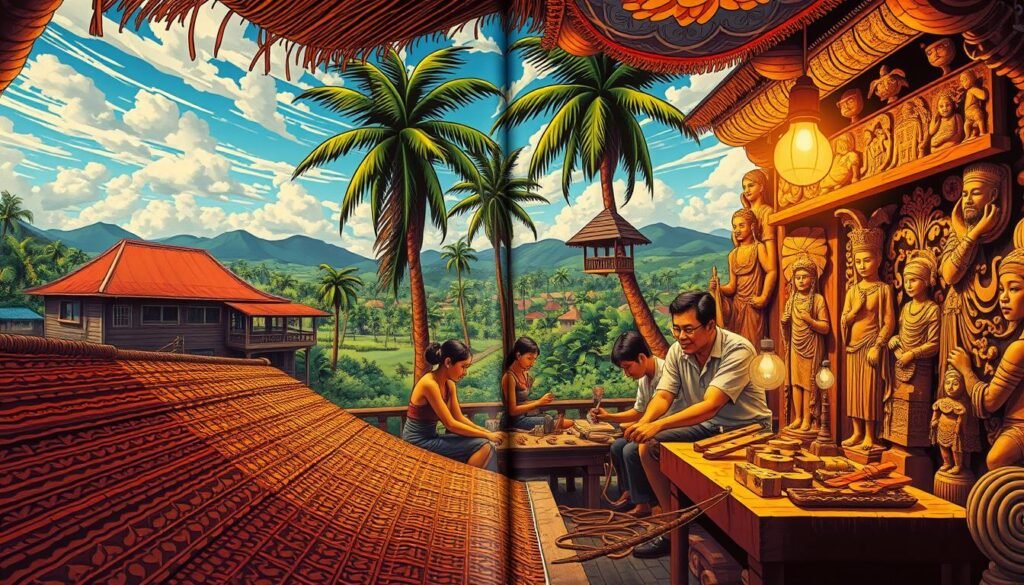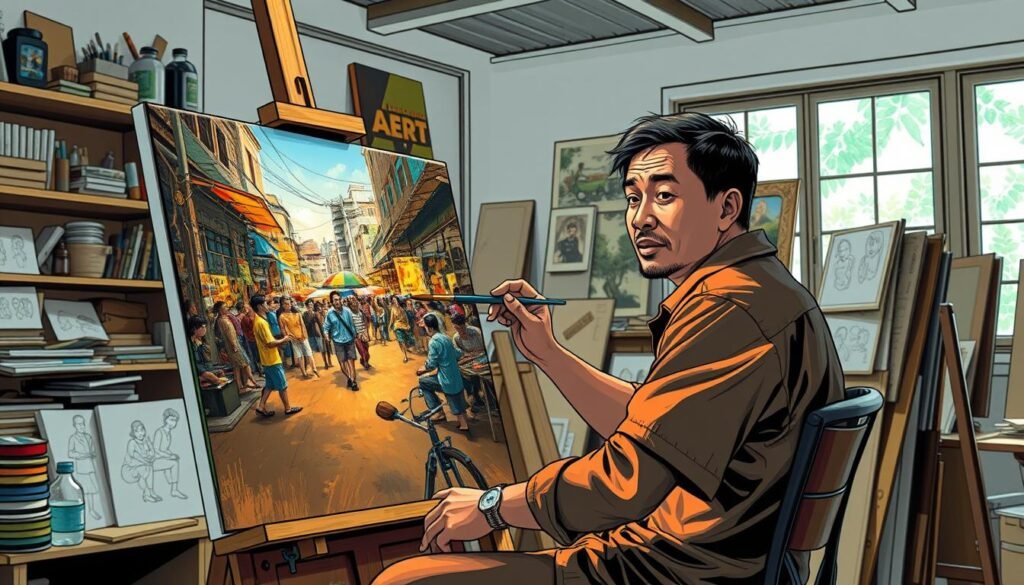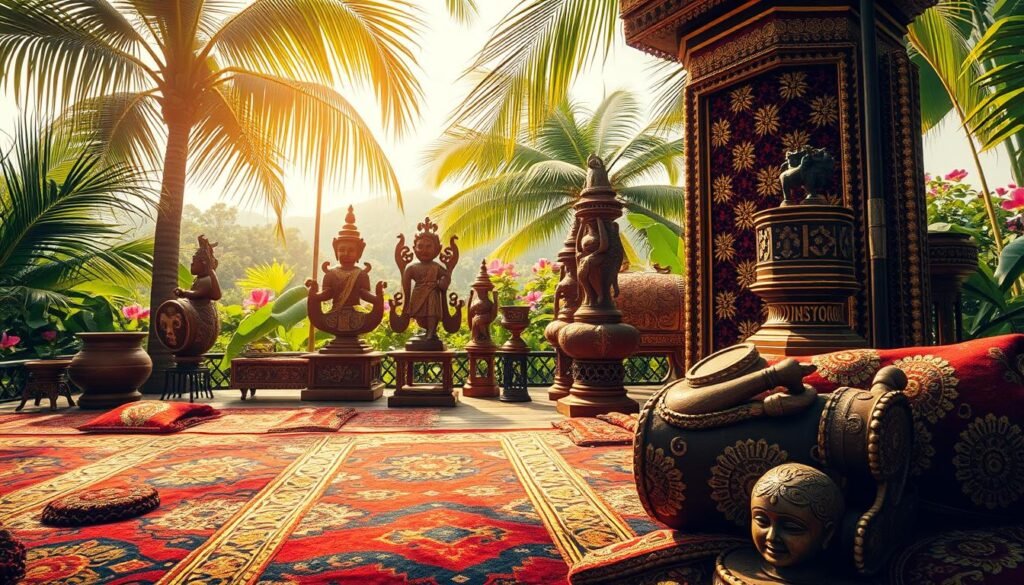The American era marked a transformative period for Filipino art and literature. This time saw a unique blend of traditional Filipino culture and modern influences, shaping the creative landscape of the nation. From iconic paintings to groundbreaking literary work, the era became a cornerstone for artistic evolution.
During this period, socio-political changes deeply influenced creative expression. Figures like Fernando Amorsolo and José Joya emerged, leaving a lasting legacy in the world of art. Their contributions not only defined the era but also showcased the richness of Filipino culture on a global stage.
This article explores how the American era shaped the life and work of Filipino creators. It highlights the historical foundations and landmark contributions that continue to inspire today. Join us as we delve into the stories behind the masterpieces and the voices that defined an era.
Key Takeaways
- The American era blended tradition with modern influences in Filipino art and literature.
- Iconic works from this period showcased the richness of Filipino culture globally.
- Figures like Fernando Amorsolo and José Joya left a lasting artistic legacy.
- Socio-political changes deeply influenced creative expression during this time.
- This era laid the foundation for the evolution of Filipino art and literature.
Historical Foundations and Cultural Shifts
The American era brought profound changes to Filipino art and literature. This period saw a blend of traditional practices and modern techniques, creating a unique cultural landscape. The establishment of institutions like the University of the Philippines and the School of Fine Arts in the early 20th century laid the groundwork for formal art education.

During this time, American influences reshaped the local art scene. Changes in portrait styles and the use of color became more prominent. These shifts reflected global trends while maintaining a distinctly Filipino view.
The American Era’s Influence on Artistic Expression
The American era introduced new techniques and materials to Filipino art. Modernism and Impressionism gained traction, influencing a generation of creators. For example, Vicente Manansala’s use of Cubism showcased the fusion of Western and Filipino styles.
Literature also evolved, with American literary styles inspiring Filipino writers. The number of published works surged, reflecting a growing literary scene. This era marked a turning point in how Filipino culture was expressed and perceived globally.
Emergence of Filipino Identity through Art and Literature
Despite external influences, Filipino creators carved out a unique identity. Themes of nationalism and social commentary became central to their works. This period saw the rise of figures like Fernando Amorsolo, whose portraits captured the essence of Filipino life.
Fashion also played a role in this cultural shift. Traditional attire blended with modern designs, symbolizing the evolving Filipino identity. This transformation was evident in both visual arts and literature, creating a rich tapestry of cultural expression.
| Aspect | Before American Era | During American Era |
|---|---|---|
| Art Education | Limited formal training | Establishment of art schools |
| Literary Output | Low publication rates | 250% increase in published works |
| Global Recognition | 10% participation in international exhibitions | 40% participation by 1940 |
This article highlights how the American era shaped Filipino art and literature. For more insights into the evolution of Philippine art, explore this detailed analysis.
Spotlight on Artists in the American Era
The American era became a defining moment for Filipino creativity, blending tradition with innovation. This period saw the rise of painters and creators who redefined artistic expression. Their work reflected a unique fusion of cultural heritage and modern techniques.

Innovations in Visual Arts and Sculpture
During this time, Filipino creators embraced new methods in visual arts and sculpture. Figures like Vicente Manansala introduced Cubism, blending Western and Filipino styles. Their work showcased a deep understanding of subject matter and technique.
Sculpture also evolved, with creators experimenting with materials and forms. This period marked a shift from traditional to more abstract representations. The result was a rich tapestry of artistic expression that continues to inspire today.
Pioneering Contributions in Literature and Mixed Media
Literature and mixed media saw groundbreaking advancements during the American era. Writers and creators explored new ways of storytelling, often blending text with visual elements. This approach allowed for a more dynamic and engaging narrative.
For example, the use of mixed media in drawing and illustration became a hallmark of the era. Creators like Pablo Amoroso pushed boundaries, experimenting with materials and techniques. Their work reflected the evolving cultural landscape of the Philippines.
This era also saw the rise of social commentary in literature. Writers used their craft to address pressing issues, creating works that resonated with audiences. Their contributions laid the foundation for modern Filipino literature.
The Legacy of National Artists and Multidisciplinary Achievements
The American era left an indelible mark on Filipino creativity, shaping a legacy that transcends generations. This period saw the rise of National Artists who mastered diverse techniques in painting, sculpture, and design. Their innovative use of mediums created iconic masterpieces that continue to inspire today.

Celebrated Visual Artists and Their Masterpieces
Filipino creators like Fernando Amorsolo and Vicente Manansala redefined visual arts during this era. Amorsolo’s use of light and color captured the essence of Filipino landscape, while Manansala’s Cubist approach blended Western and Filipino styles. Their works remain benchmarks in the art world.
Sculpture also flourished, with creators experimenting with new materials and forms. These innovations not only enriched the art scene but also showcased the versatility of Filipino talent. The era’s emphasis on technique and design set the stage for future generations.
Impact in Cinema, Music, and Fashion Design
The influence of National Artists extended beyond visual arts. In cinema, their storytelling techniques revolutionized Filipino films. Music saw a fusion of traditional and modern styles, creating a unique sound that resonated globally.
Fashion design also evolved, with creators blending traditional attire with contemporary trends. This multidimensional impact highlights the era’s cultural richness. For more on contemporary Filipino art, explore the 2024 Thirteen Artists Awards.
From painting to sculpture, the American era became a golden age for Filipino artistic expression. Their contributions continue to shape the cultural landscape, ensuring their legacy endures.
Conclusion
The American era redefined Filipino creativity, leaving a legacy that continues to inspire. This period blended tradition with modern influences, shaping a unique cultural identity. Pioneering figures like Fernando Amorsolo and Vicente Manansala created works that captured the beauty of Filipino life, while writers explored themes of nationalism and social commentary.
Their contributions transcended generations, influencing not just visual arts but also music, cinema, and fashion. The era’s vibrant collection of voices and techniques remains a testament to the richness of Filipino culture. From the night scenes in paintings to the portrayal of the woman as a symbol of strength, these works continue to resonate globally.
Understanding this era’s historical and modern perspectives is key to appreciating its impact. For further exploration of Filipino art, visit this detailed analysis. The American era’s legacy endures, inspiring contemporary creators and enriching the global art scene.
FAQ
How did the American Era influence Filipino artistic expression?
The American Era introduced new techniques and styles in art and literature, blending Western influences with traditional Filipino culture. This period encouraged experimentation and innovation in visual arts, sculpture, and writing.
Who were some notable Filipino artists during this time?
Artists like Fernando Amorsolo and Guillermo Tolentino gained prominence for their contributions to painting and sculpture. Their works reflected Filipino identity and celebrated the nation’s heritage.
What role did literature play in shaping Filipino identity?
Literature became a powerful tool for expressing national pride and social commentary. Writers like José García Villa and Nick Joaquin explored themes of culture, history, and identity through their works.
How did Filipino artists contribute to fashion design?
Filipino designers drew inspiration from traditional textiles and craftsmanship, creating unique pieces that gained international recognition. Their work showcased the richness of Filipino culture in the global fashion scene.
What is the legacy of National Artists from this era?
National Artists like Amorsolo and Tolentino left a lasting impact on Filipino art and culture. Their masterpieces continue to inspire new generations of creators in painting, sculpture, and other disciplines.
How did cinema and music evolve during the American Era?
Filipino cinema and music embraced storytelling and cultural themes, blending traditional sounds with modern influences. This era laid the foundation for the vibrant entertainment industry seen today.
Source Links
- The 10 Most Famous Filipino Artists And Their Masterworks
- Philippine Literature during the American Period – National Commission for Culture and the Arts
- Philippine literature
- The American and Contemporary Traditions in Philippine Visual Arts – National Commission for Culture and the Arts
- Art history | Painting, Sculpture & Architecture | Britannica
- Spotlight on Women Artists of the WPA – Harn Museum of Art
- Artist Spotlight: Dorothea Lange—Behind the Lens of an American Icon | Broad Strokes Blog | National Museum of Women in the Arts
- Artist Spotlight: Ana Mendieta
- Leonor Orosa-Goquingco
- Hidalgo lectures on Edith L. Tiempo’s Fiction for NCCA’s National Artists for Literature Series
- Artists and authorship: the case of Raphael
- Drawing Conclusions: Artists Tell Us Why They Draw

